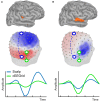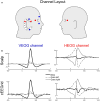Concealed, Unobtrusive Ear-Centered EEG Acquisition: cEEGrids for Transparent EEG
- PMID: 28439233
- PMCID: PMC5383730
- DOI: 10.3389/fnhum.2017.00163
Concealed, Unobtrusive Ear-Centered EEG Acquisition: cEEGrids for Transparent EEG
Abstract
Electroencephalography (EEG) is an important clinical tool and frequently used to study the brain-behavior relationship in humans noninvasively. Traditionally, EEG signals are recorded by positioning electrodes on the scalp and keeping them in place with glue, rubber bands, or elastic caps. This setup provides good coverage of the head, but is impractical for EEG acquisition in natural daily-life situations. Here, we propose the transparent EEG concept. Transparent EEG aims for motion tolerant, highly portable, unobtrusive, and near invisible data acquisition with minimum disturbance of a user's daily activities. In recent years several ear-centered EEG solutions that are compatible with the transparent EEG concept have been presented. We discuss work showing that miniature electrodes placed in and around the human ear are a feasible solution, as they are sensitive enough to pick up electrical signals stemming from various brain and non-brain sources. We also describe the cEEGrid flex-printed sensor array, which enables unobtrusive multi-channel EEG acquisition from around the ear. In a number of validation studies we found that the cEEGrid enables the recording of meaningful continuous EEG, event-related potentials and neural oscillations. Here, we explain the rationale underlying the cEEGrid ear-EEG solution, present possible use cases and identify open issues that need to be solved on the way toward transparent EEG.
Keywords: ear EEG; ear-centered EEG; mobile EEG; transparent EEG; wearable EEG.
Figures










References
-
- Bertrand A., Mihajlovic V., Grundlehner B., Van Hoof C., Moonen M. (2013). Motion artifact reduction in EEG recordings using multi-channel contact impedance measurements, in 2013 IEEE Biomedical Circuits and Systems Conference (BioCAS), (IEEE; ) 258–261.
LinkOut - more resources
Full Text Sources
Other Literature Sources
Miscellaneous

